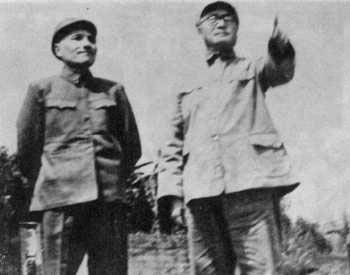2nd Field Army on:
[Wikipedia]
[Google]
[Amazon]
 The Second Field Army (第二野战军), initially known as the Central Plains Field Army (中原野战军) or the Liu-Deng Army, was a major
The Second Field Army (第二野战军), initially known as the Central Plains Field Army (中原野战军) or the Liu-Deng Army, was a major
 The Second Field Army (第二野战军), initially known as the Central Plains Field Army (中原野战军) or the Liu-Deng Army, was a major
The Second Field Army (第二野战军), initially known as the Central Plains Field Army (中原野战军) or the Liu-Deng Army, was a major military formation
Military organization or military organisation is the structuring of the armed forces of a State (polity), state so as to offer such military capability as a military policy, national defense policy may require. In some countries paramilitary ...
of the Chinese Communist Party
The Chinese Communist Party (CCP), officially the Communist Party of China (CPC), is the founding and sole ruling party of the People's Republic of China (PRC). Under the leadership of Mao Zedong, the CCP emerged victorious in the Chinese Civil ...
during the last stages of the Chinese Civil War
The Chinese Civil War was fought between the Kuomintang-led government of the Republic of China and forces of the Chinese Communist Party, continuing intermittently since 1 August 1927 until 7 December 1949 with a Communist victory on m ...
.
The Second Field Army took control of PLA troops in central China, with Liu Bocheng
Liu Bocheng (; December 4, 1892 – October 7, 1986) was a Chinese military commander and Marshal of the People's Liberation Army.
Liu is known as the 'half' of the "Three and A Half" Strategists of China in modern history. (The other th ...
as commander and Deng Xiaoping
Deng Xiaoping (22 August 1904 – 19 February 1997) was a Chinese revolutionary leader, military commander and statesman who served as the paramount leader of the People's Republic of China (PRC) from December 1978 to November 1989. After CCP ...
as commissar.Historical Dictionary of Modern China (1800-1949), James Zheng Gao, Scarecrow Press, 2009, , 116 It comprised three armies: the 3rd Army (10th, 11th Corps, and 12th Corps) 4th Army (13th, 14th, and 15th Corps), and 5th Army (16th, 17th Corps and 18th Corps), plus a special technical column, and totalled 128,000 men. After 1949, the Second Field Army was stationed in southwest China and controlled five provinces - Yunnan
Yunnan , () is a landlocked province in the southwest of the People's Republic of China. The province spans approximately and has a population of 48.3 million (as of 2018). The capital of the province is Kunming. The province borders the C ...
, Guizhou
Guizhou (; formerly Kweichow) is a landlocked province in the southwest region of the People's Republic of China. Its capital and largest city is Guiyang, in the center of the province. Guizhou borders the autonomous region of Guangxi to the ...
, Sichuan
Sichuan (; zh, c=, labels=no, ; zh, p=Sìchuān; alternatively romanized as Szechuan or Szechwan; formerly also referred to as "West China" or "Western China" by Protestant missions) is a province in Southwest China occupying most of the ...
, Xikang
Xikang (also Sikang or Hsikang) was a nominal province
formed by the Republic of China in 1939 on the initiative of prominent Sichuan warlord Liu Wenhui and continued by the early People's Republic of China. Thei idea was to form a single unif ...
, and Tibet
Tibet (; ''Böd''; ) is a region in East Asia, covering much of the Tibetan Plateau and spanning about . It is the traditional homeland of the Tibetan people. Also resident on the plateau are some other ethnic groups such as Monpa, Taman ...
.
The 15th Army ("Corps") was transferred to the Second Field Army in 1950..
References
External links
* http://www.orbat.info/history/volume6/PLA%201st%20and%202nd%20Field%20Armies%201949.htm - Bajwa listing of divisions 1949, probably drawing on William W. Whitson, with Chen-hsia Huang. (1973) The Chinese high command; a history of Communist military politics, 1927–71. Foreword by Lucian W. Pye. {{Corps and Armies of the People's Liberation Army Field armies of the People's Liberation Army Military units and formations established in 1949